How much CO2 do we emit from domestic air travel each week?
In an increasingly globalised world, aviation is one of the fastest growing contributors to greenhouse gas emissions.
Aviation currently accounts for 2% of CO2 emissions globally and 6% of the UK’s annual CO2 emissions. If global aviation was a country, it would be in the top 10 for highest CO2 emissions. That’s up there with China, the US, India, Russia, Japan, Germany, South Korea, Iran, Canada and Saudi Arabia.
But how should we deal with it?
Greta Thunberg’s recent transatlantic trip has split opinion. On the one hand, she exhibited exactly the kind of selflessness and determination we need if we are going to make serious progress towards a reduction in global heating. On the other hand, her journey was largely symbolic and utterly impractical - even some of the crew members were forced to fly home.
The average passenger does not have access to a £3.7million carbon-fibre yacht - and even if they did, they probably wouldn’t commit 15 days of their holiday allowance to an unnecessarily cold and blustery journey across the pond.
So, perhaps cutting out air travel for overseas journeys isn’t the most practical option. But what about domestic flights?
Here at personal lease and business lease comparison site Lease Fetcher, we are tackling this big question head on!
Are domestic flights really that bad?
In 2017, 23 million domestic passengers made up 9% of all passengers from the UK. The total number of domestic passengers has fallen by 20% since 2007. It declined sharply in the years after the financial crash and began to slowly rebound by 2013. International flights, on the other hand, have continued to soar.
This might sound like good news for environmentalists. One of the quirks of flying, however, is that shorter flights have a much greater environmental impact per person than long-haul flights. That’s because the take-off and landing stages of the flight are the most inefficient.
Our research used the Eurocontrol Small Emitters Tool and Greenhouse Gas Conversion Factors provided by the Department for Environment, Food and Rural Affairs to provide an insight into how much CO2 is released by planes from the top 5 busiest airports for domestic flights to London.
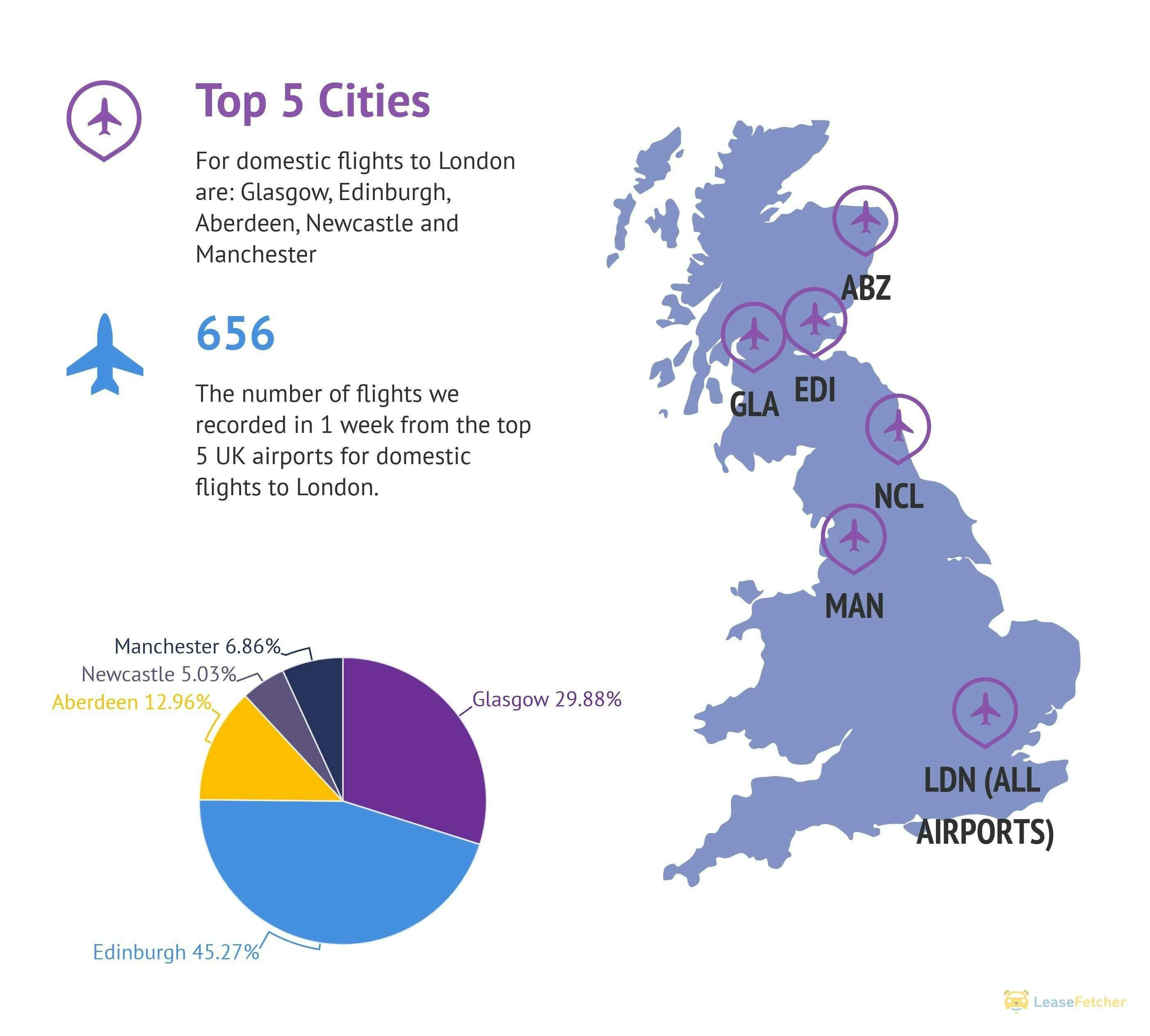
How much can a few domestic flights really add up to?
From the 4th to the 10th of November, 2019, there were 656 flights to London from the 5 UK airports with the most flights to the British capital: Glasgow, Edinburgh, Newcastle, Manchester and Aberdeen.
It can be difficult to conceptualise numbers this large - more so to imagine exactly what they mean when applied to an ever-present but invisible gas - so we’re going to try and put that into perspective:

(Mixed Sources, incl. EPA Greenhouse Gas Equivalencies Calculator, Science.HowStuffWorks, CO2 Weight/Volume Conversion Calculator, Air Products Calculator, Modern Airliners Boeing Specs, Sea World, Container Container)
Ok, but how much does each individual emit?
Emissions from UK domestic flights can range from 39kg/passenger on a flight from Manchester to London Heathrow to 71kg/passenger from Aberdeen to London Southend, based on a plane that is between 69 - 82% full, calculated using figures provided by DEFRA.
That may not seem like much, but by taking a domestic flight you continue to make it a commercially viable option for the airline. For each flight, that’s anywhere between 4 - 7 tonnes of CO2 emissions.
How does this compare to other forms of transport?
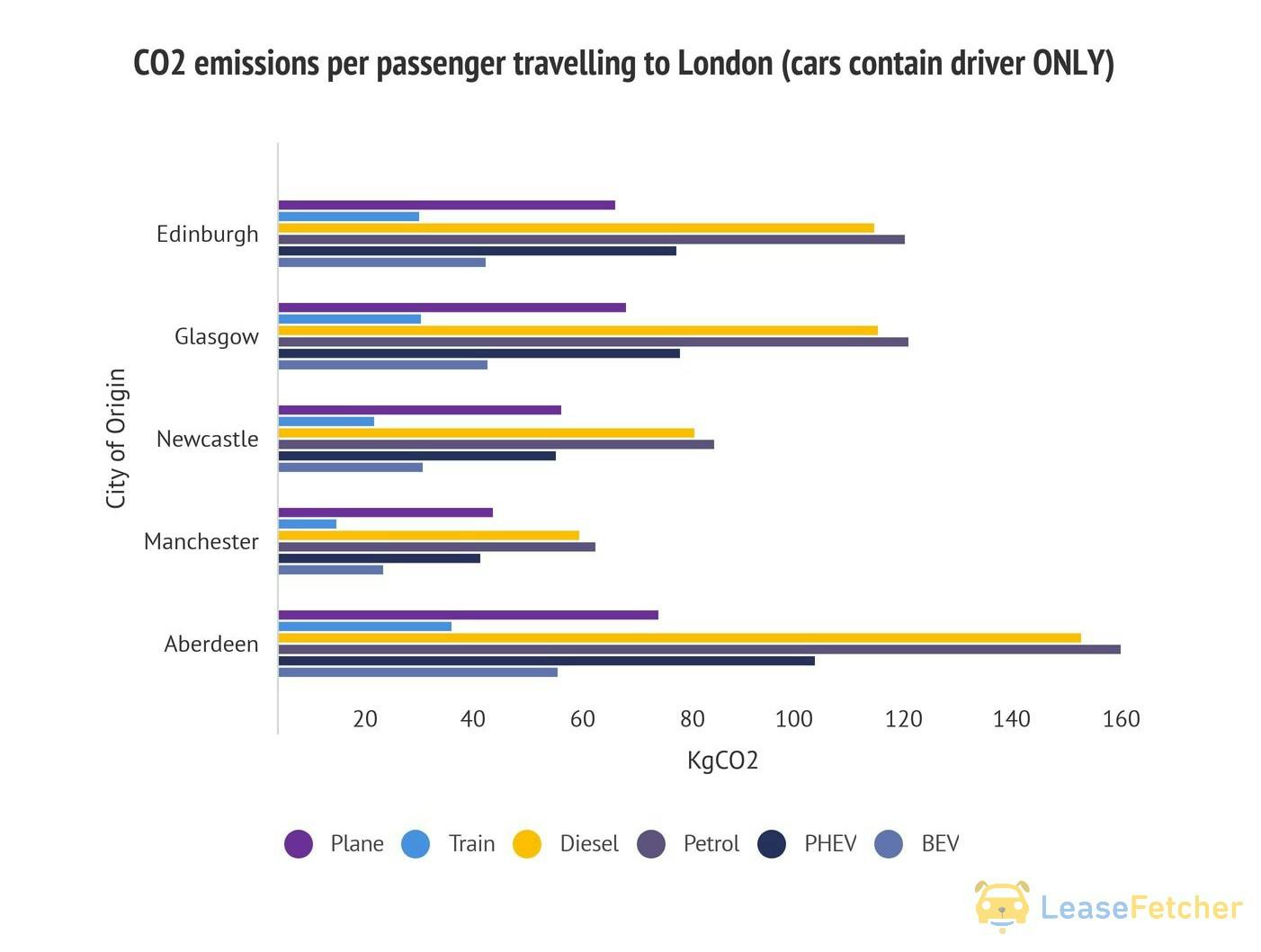
Above: Average emissions compared between planes, trains and cars with only one person per car (Source: DEFRA Conversion Factors, 2019)
Travelling by train
At 25.7kg/passenger, a train from Glasgow to London Euston would reduce your CO2 emissions by almost 60% compared to flying, while getting a train from Manchester to London could reduce your carbon footprint by as much as 73%!
Yes, trains do take longer, but do you really enjoy waiting in a queue for security only to frantically empty your hand luggage and enjoy a complimentary pat down? Once you’re at the train station, it’s as simple as stepping onto the train and taking your seat.
Airports advise you arrive 90 minutes early for a domestic flight, and while a seasoned air-traveller might make it to the gate in significantly less time, you still have to factor in travel time to and from each airport and the potential line at security.
There are 45 flights each week from Manchester to London Heathrow. That’s about 194,444kgCO2 each week. Flights are 55 minutes, but when you allow for getting into the airport, past security and actually boarding the plane this could easily take upwards of 2 hours - especially if you’re travelling at peak time. When you compare this to a train from Manchester to London Euston which takes on average 2 hours and 10 minutes, flying just seems silly!
Sure, it’s a bit more of a commitment to go from Glasgow or Edinburgh to London. It takes about 4 and a half hours from each by train. But that’s also 4 and a half hours that you can spend productively. That’s a solid chunk of time to get to work on your laptop, prepare for that meeting or finish off that book you’ve been reading.
It’s important to remember that even though you may only be on the plane for an hour and a half, you’ll need to travel to the airport, find parking, stand in queue for security and boarding and finally, the last leg of the journey, get from the airport to your final destination. Phew, what a trip!
Travelling by car
If you decide to travel by car alone, you won’t be doing the environment any favours on the long haul. The average emissions per vehicle, in every type of car except a Battery Electric Vehicle, are higher than those for an average passenger taking a plane.
If you’re an early adopter of the Tesla Model 3, you’re probably feeling pretty smug right now.
However, even if you travel with just one passenger (2 including the driver), petrol and diesel cars will be a more environmentally friendly mode of transport for all but the longest journeys - in this case, from Aberdeen to London.
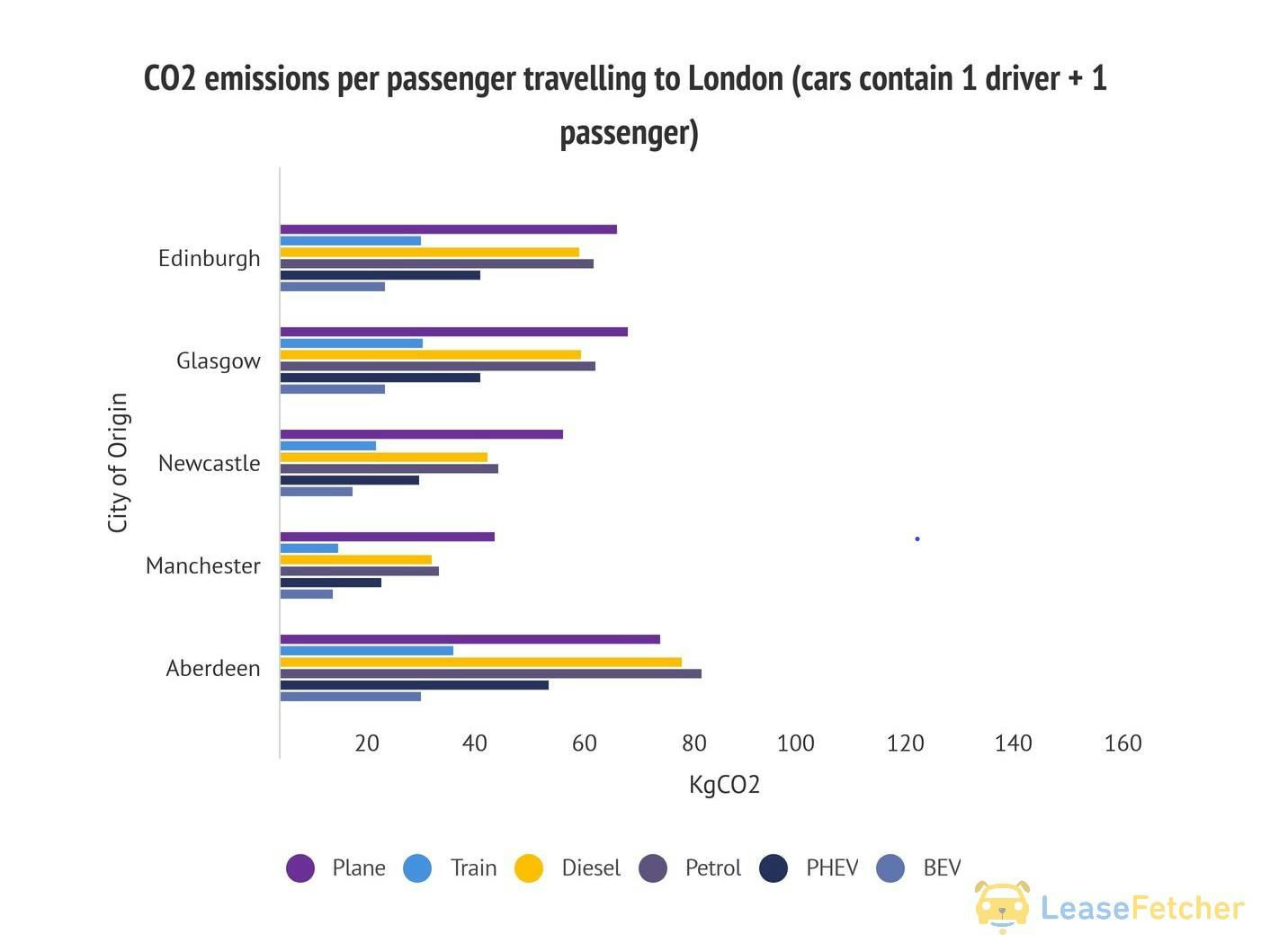
Above: Average emissions per person compared between planes, trains and cars with a driver and one passenger (Source: DEFRA Conversion Factors, 2019).
Of course, the more passengers you can cram into your car, the more you’ll save…
Unfortunately, when it comes down to the length of the journey, cars still struggle to compete.
A 9 hour long drive from Aberdeen to London is unlikely to appeal to anybody when a plane will get them there in 1 hour and 20 minutes. Plus, that’s a lot of fuel (£££) or a good few stops along the way for some of that electric cable juice.
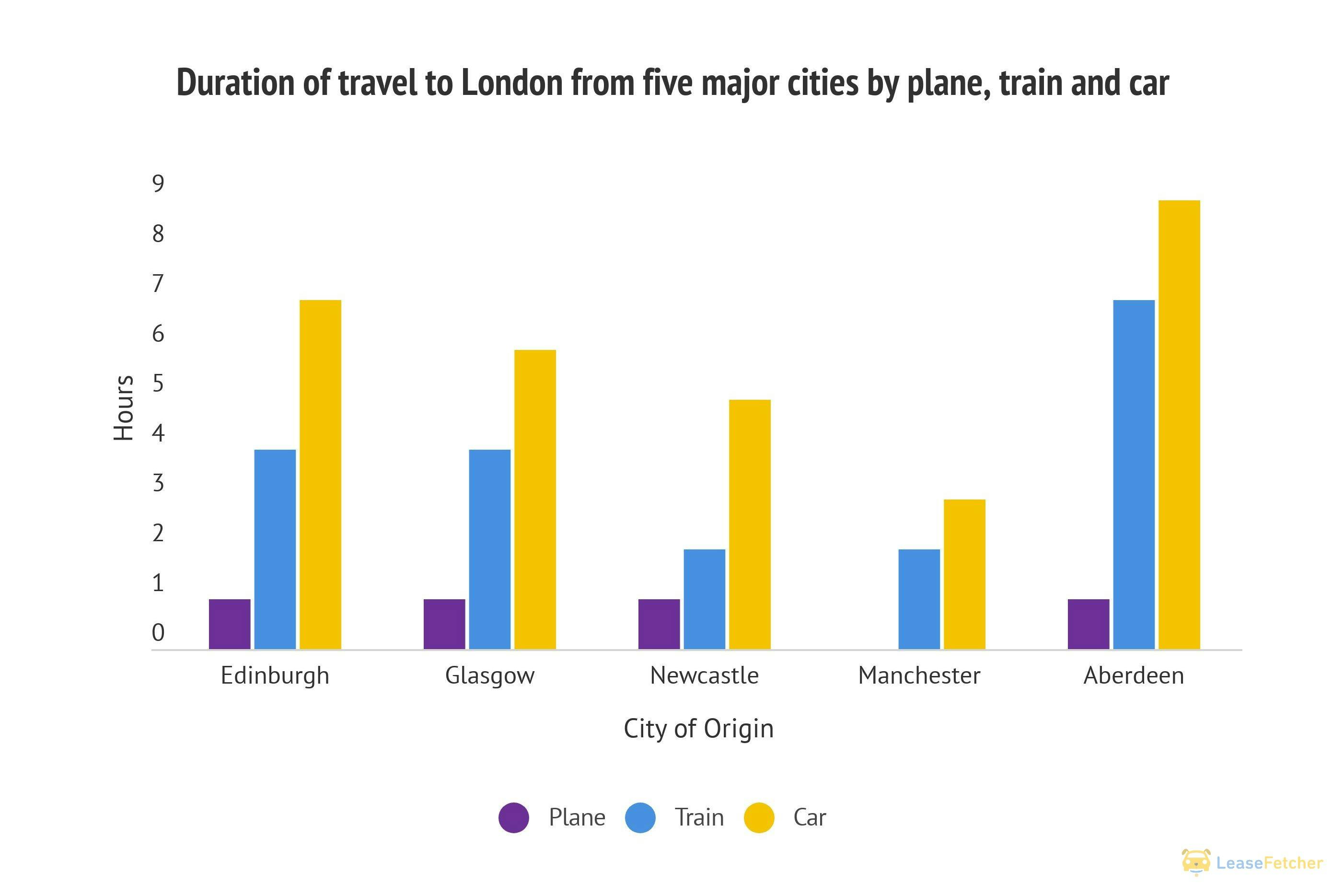
Above: Average journey time for passengers travelling to London by plane, train and car, by city of origin (Source: Google Maps)
The proposed High Speed 2 Railway could cut nearly an hour off of train journeys from Glasgow to London Euston and save 45 minutes on trips from Edinburgh to London King’s Cross. Unfortunately, for those travelling from Aberdeen to London, flying may still be the most practical option if you’re travelling alone.
What is the UK Government doing?
Earlier this year, the Environment Secretary Michael Gove pledged £10million to plant over 130,000 urban trees over the next 2 years. While this will go some way to reducing inner-city levels of pollution, our calculations suggest that this would sequester no more CO2 than is produced in two weeks of domestic flights to London - less if you include the return flight.
The UK Government already imposes one of the highest rates of tax on any passenger departing from a UK airport: £13 per person per flight. Someone taking a round-trip domestic flight would have to pay £26 of air passenger duty for the privilege.
Responsible Travel argue that this should be increased and renamed the ‘Green Flying Duty’ to discourage domestic flights.
The UK Green Party also suggested a ‘frequent flyer’ levy earlier this year. Currently, 15% of passengers make up a whopping 70% of the flights. This new tax would hit those who travelled by plane more than once a year.
What are airlines doing?
British Airways recently pledged to ‘carbon offset’ all of its domestic flight emissions from next year. It’s also the first airline to commit to net-zero carbon flying by 2050.
Our data shows that British Airways accounts for 62% of all emissions and flights from the 5 airports in our study. That’s over 2,727 tonnes of CO2 on domestic planes into London each week. That’s the combined weight of almost 15 Boeing 747s and the volume of 595 Olympic swimming pools at 21’C.
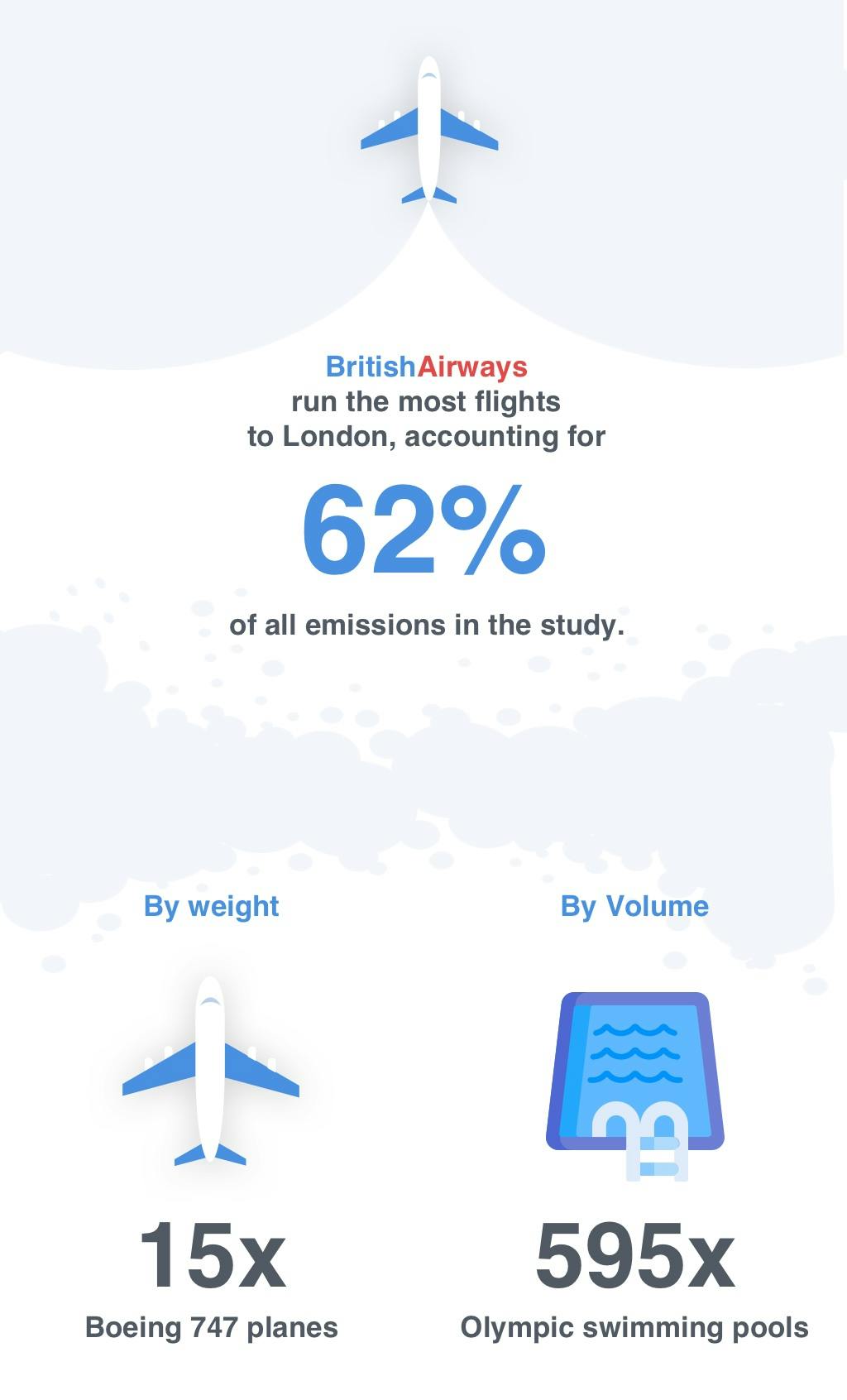
British Airways isn’t the only airline that has been making moves towards a more sustainable future. Ryanair has been offering a voluntary carbon offsetting scheme for some time now, with users able to pay an additional fee at the checkout to offset their emissions. What sets BA apart, is that all of their flights will be offset, without the requirement to opt-in.
Scottish airline Loganair is already pioneering electric aircraft for its Westray to Papa Westray route, while EasyJet and Flybe have also committed to upgrading to a more efficient fleet.
So, what is carbon offsetting?
It can include investing in renewables such as solar and wind energy but more often than not involves large scale afforestation.
Ryanair’s funds go towards three afforestation schemes: First Climate (Uganda), Renature Monchique and Native Woodland Trust, as well as the Irish Whale and Dolphin group. BA has previously invested in the protection and reforestation of the Cordillera Azul National Park, Peru as well as the rainforest of the Cardamom Mountains in Cambodia.
Is carbon offsetting with trees really the answer?
If you’re young and technologically-savvy, or you were paying close attention to the news around the time of the fires in the Amazon rainforest, chances are you’ll have heard of Ecosia.
Founded in 2009, the sustainable search engine proudly asserts that it is CO2 negative, investing 80% of its profits into planting trees. It claims:
“By planting trees and offsetting its energy use with renewables, each search with Ecosia actually removes 1 kg of CO2 from the air, which makes Ecosia a carbon-negative search engine. Here’s the math: an average search generates around 0.005 € of revenue. It costs roughly 0.25 € to plant a tree, which means that Ecosia can plant one tree every 50 searches. On average, these trees will each remove 50 kg of CO2 during an expected 15-year lifetime.”
The average person makes 3-4 searches a day. For many of us, that figure is probably closer to 100+ searches a day.
Using their calculations, it would take an ‘average user’ just over 12 and a half days to offset their emissions from the average domestic flight from Newcastle to London.
By the same logic, if everybody using Google was to convert to Ecosia, we could plant 1,260 trees per second or 112,000,000 trees each day using the money accrued from ads. Theoretically speaking. Last year, the search engine argued that if they were as big as Google, they could “absorb 15% of all global CO2 emissions”.
But can we really content ourselves with offsetting our flight emissions by adding an extra £1 to the ticket price, making the move from ‘Googling’ to searching with Ecosia, or joining @Treelon Musk in donating to #TeamTrees?
Well, to put Ecosia’s own figures into perspective, it would take 15 years for one of their trees to sequester 50kg of CO2.
Let us rephrase that: If you choose to carbon offset by planting one tree, it would take 15 years to offset that flight from Newcastle to London.
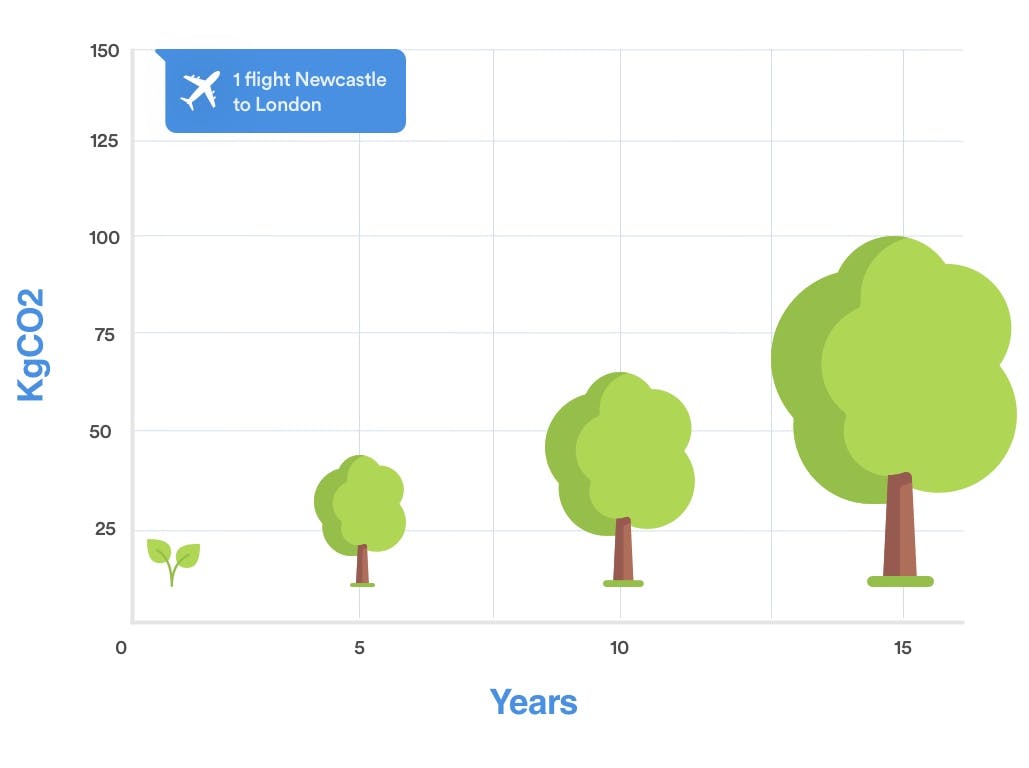
There are other major issues with this strategy. For starters, the amount of CO2 absorbed by trees can vary greatly between species. Many carbon offsetting tree planters will use quick-growing varieties which lock in a fraction of the amount of CO2 that a larger tree might sequester over its lifetime. Great in the short term, but less effective in the long run…
With many of these carbon offsetting schemes, there are also no guarantees that your tree will survive into adulthood.
But how much can we actually offset?
Planting ‘a trillion trees’ is not the solution
A recent paper published in Science suggests that there is room for an extra 0.9 billion hectares of canopy cover, which could sequester 205 gigatonnes of carbon in areas that would naturally support woodland and forests. It then goes on to state that failure to act soon could see the total potential for additional canopy cover reduced to just a 223million hectares by 2050, as the land becomes less hospitable.
A response to this paper suggests that it made a number of crucial oversights. Firstly, it may be overestimating the amount of carbon that an extra 0.9 billion hectares of tree coverage could bring. The authors have neglected the carbon that is already stored in vegetation and degraded soil that the new forests would seek to replace. The additional capacity for carbon storage would only amount to the difference between the two.
Secondly, while forests can absorb a lot of carbon, it can take centuries for them to reach their full potential.
The paper also ignores the ‘warming’ effects of planting trees in snow covered areas, which would reduce “albedo” - the amount of light and heat which is reflected rather than absorbed.
Crucially, at our current emission rate of 10 GtC per year, even if we used all of the available space for planting trees, the extra 205Gt of sequestered carbon would only just cover the amount we emit over the next 20 years.
So, what can we do?
Offsetting can help, but if we are to make a lasting impact in reducing global heating and CO2 emissions, there needs to be a radical reduction in fossil carbon emissions.
That means reducing anthropogenic CO2 emissions to net zero, by the second half of the century, in line with the Paris Climate Agreement.
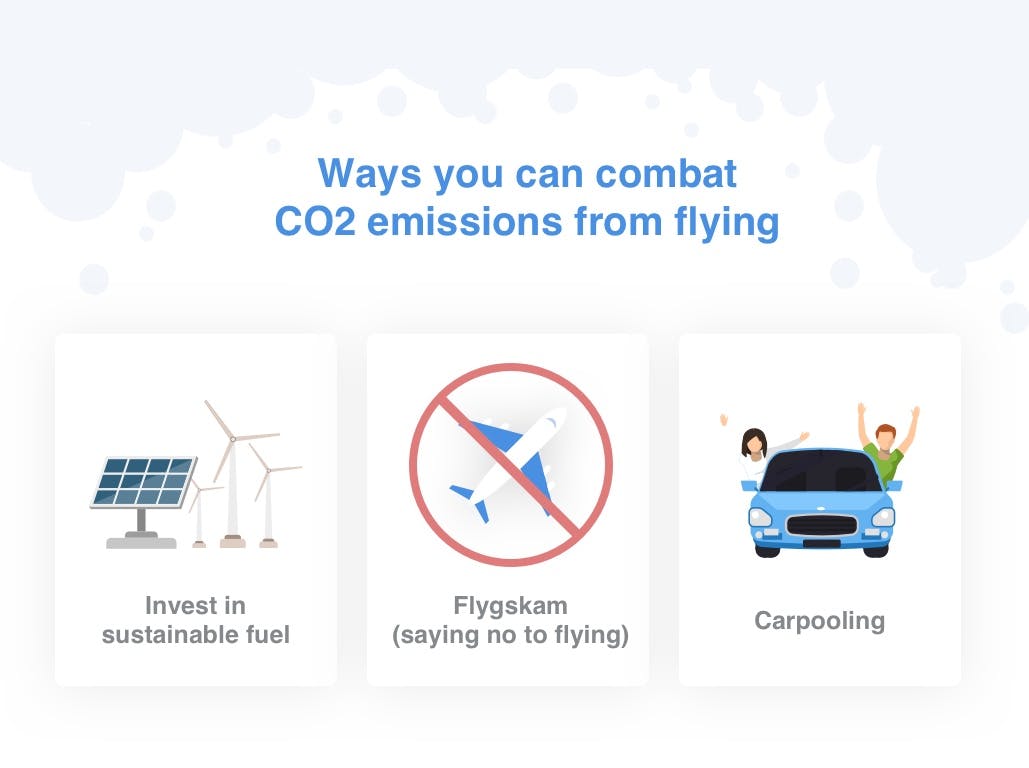
Sustainable Aviation Fuels
Rather than investing in trees that will absorb your emissions 10, 20 or 30 years down the line, Sustainable Aviation Fuels offer immediate benefits, by dramatically reducing the amount that you emit in the first place.
Using Lufthansa’s new Compensaid platform, users can invest in Sustainable Aviation Fuel which releases 80% less CO2 than normal jet fuel. Lufthansa promise the donation will be used within 6 months of investing. There are a number of processes available for producing SAF, but most consist of agricultural and food waste. It is currently 3x more expensive than jet fuel to manufacture, so increasing demand is important for reducing costs.
British Airways has also announced plans to purchase sustainable jet fuel from UK-based Velocys after they announced their intention to build a waste to fuel plant at Immingham, North East Lincolnshire earlier this year. Whether this will come at an additional, opt-in cost to the passenger, as with Lufthansa, is as yet unclear.
“Flygskam”
If social media has proved one thing, it is that there are few things quite as effective as peer pressure.
The Swedish word “Flygskam” translates literally as “flight shame”. It is a social phenomenon which saw the number of passengers at Sweden’s top 10 busiest airports decline by 8% since the start of 2019. The impact has been so dramatic that Swedish train operator SJ has pledged to double its capacity over the next 5 years.
While some have been critical of the movement for the pressures it puts on the individual as opposed to the airline, we’d argue that swapping a plane for a train shouldn’t be that much of an inconvenience.
Collective action can make a difference. As UK domestic air travel has become less popular in recent years, airlines have been forced to end services. Loganair have closed their Edinburgh-Inverness route, while British Airways have stopped flights from Manchester to Gatwick.
Our research shows that taking a train instead of a domestic flight can go a long way…
And yes, the Swedes have a word for it too - “Tagskryt” or “train bragging”.
Carpooling
If you know people that are heading in the same direction, or you don’t mind catching a ride with new people, then carpooling is a great option for getting from A to B with fewer emissions.
Apps like Carma Carpooling and BlaBlaCar make it easier than ever to find someone making the same journey.
Conclusion
‘Offsetting’ may be a buzzword right now, and it may be helping - but it doesn’t solve the immediate issue of tonnes of CO2 being released into the atmosphere!
By cutting out domestic flights, we can massively reduce the amount of CO2 that we emit in the first place - whether that means carpooling, catching the train or even joining the #travelless movement.
You’re an automotive website - what are you doing writing about domestic travel and emissions?
Brilliant question.
Yes we are a lease comparison website and by defacto compare cars, but we also care a great deal about the environment. We are keen to do what we can to bring a little attention to what’s becoming a big problem; the consumption and the following emissions of today’s constantly increasing living standards.
We know that for international travel, there are only so many modes of transport available at the moment. As mentioned, we don’t all have access to a 0 emission carbon yacht, nor the annual leave to make the journey across the pond.
A small change can sometimes reap great rewards so we decided to dig into the topic of domestic flights.
We had a hunch that domestic travel was a big market but were genuinely surprised by how many planes take off for London on a weekly basis.
The goal of this report was simply to shine some light on an issue that we don’t think people really think about; short-haul, usually dead cheap, environmentally damaging flights.
We’ve looked into how much effort it would take to get from A to B without putting the same strain on the environment. For domestic travels, all modes of transport are about the same length/duration (all things considered), cost about the same but emit very different levels of CO2.
To round up, we’d like to encourage everyone to be a little smarter about how they travel. Delete that RyanAir BIG WINTER SALES £5.99 RETURN TO LONDON email and book a train ticket or carpool with a friend or colleague instead! You can thank us when you pull into the centre of London fully rested, fed and ready for the day!

